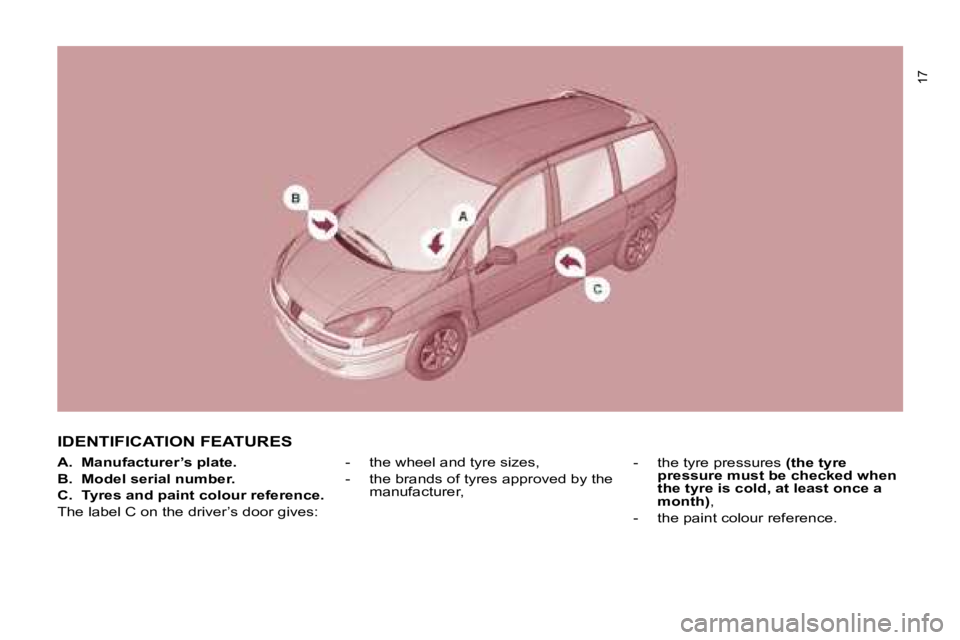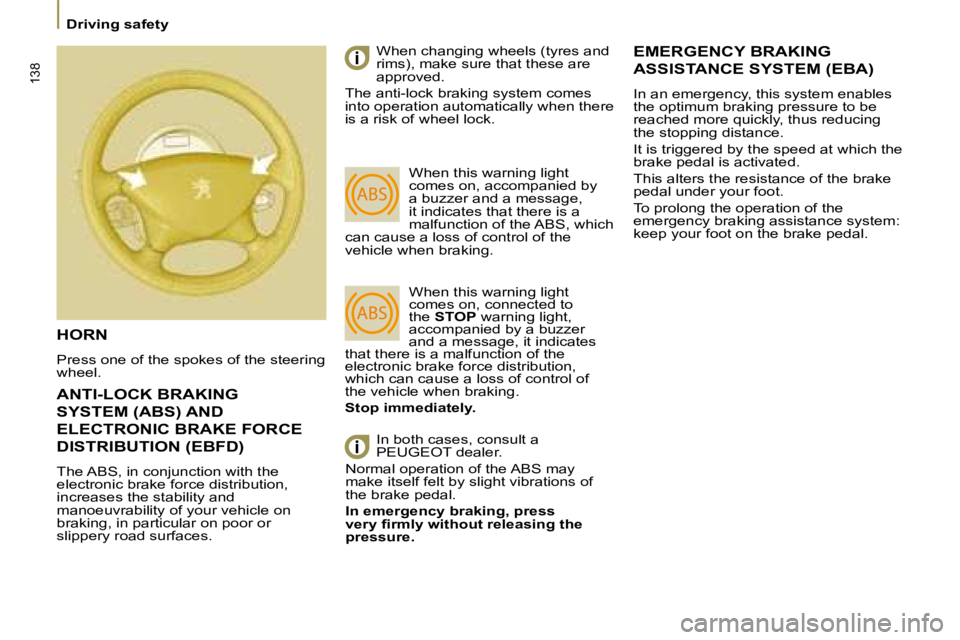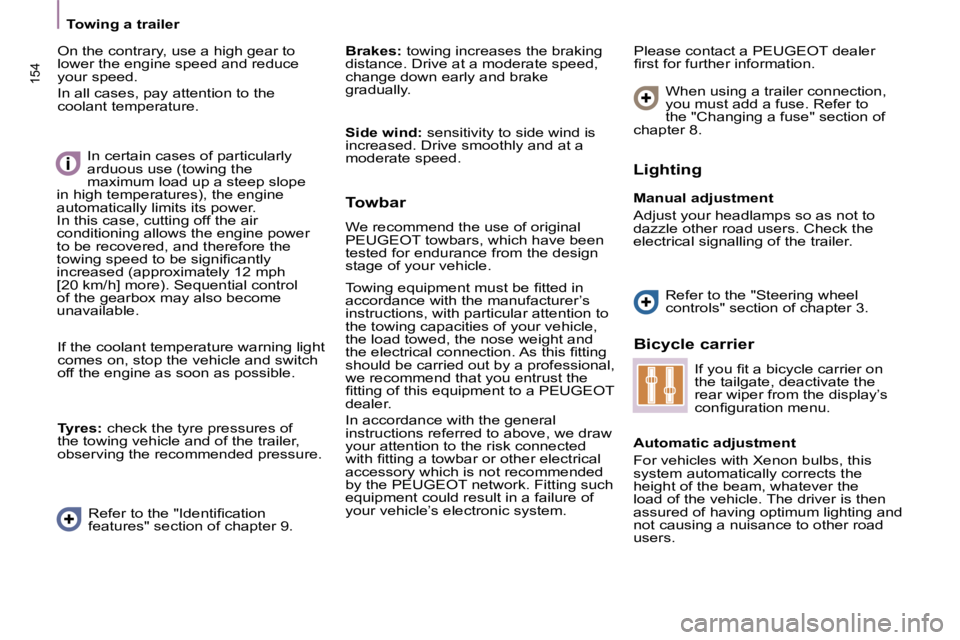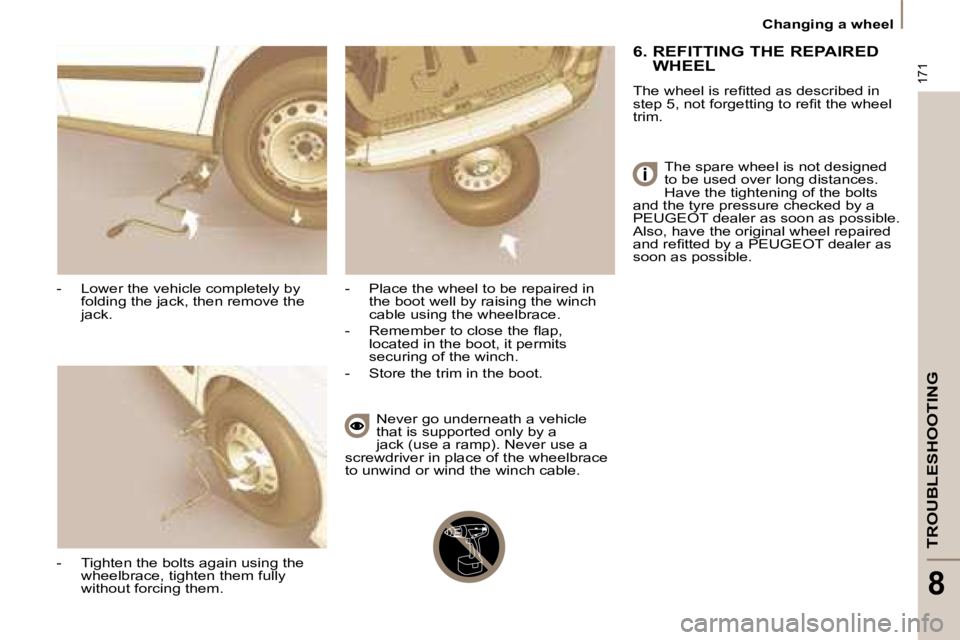tyre pressure PEUGEOT 807 2008 Owners Manual
[x] Cancel search | Manufacturer: PEUGEOT, Model Year: 2008, Model line: 807, Model: PEUGEOT 807 2008Pages: 194, PDF Size: 5.17 MB
Page 12 of 194

17
IDENTIFICATION FEATURES
- the wheel and tyre sizes,
- the brands of tyres approved by the manufacturer, - the tyre pressures
(the tyre
pressure must be checked when
the tyre is cold, at least once a
month) ,
- the paint colour reference.
A.
Manufacturer’s plate.
B. Model serial number.
C. Tyres and paint colour reference.
The label C on the driver’s door gives:
Page 133 of 194

138
Driving safety
ANTI-LOCK BRAKING
SYSTEM (ABS) AND
ELECTRONIC BRAKE FORCE
DISTRIBUTION (EBFD)
The ABS, in conjunction with the
electronic brake force distribution,
increases the stability and
manoeuvrability of your vehicle on
braking, in particular on poor or
slippery road surfaces.
HORN
Press one of the spokes of the steering
wheel.When changing wheels (tyres and
rims), make sure that these are
approved.
The anti-lock braking system comes
into operation automatically when there
is a risk of wheel lock.
When this warning light
comes on, accompanied by
a buzzer and a message,
it indicates that there is a
malfunction of the ABS, which
can cause a loss of control of the
vehicle when braking.
When this warning light
comes on, connected to
the STOP warning light,
accompanied by a buzzer
and a message, it indicates
that there is a malfunction of the
electronic brake force distribution,
which can cause a loss of control of
the vehicle when braking.
Stop immediately.
In both cases, consult a
PEUGEOT dealer.
Normal operation of the ABS may
make itself felt by slight vibrations of
the brake pedal.
In emergency braking, press
�v�e�r�y� �i�r�m�l�y� �w�i�t�h�o�u�t� �r�e�l�e�a�s�i�n�g� �t�h�e�
pressure.
EMERGENCY BRAKING
ASSISTANCE SYSTEM (EBA)
In an emergency, this system enables
the optimum braking pressure to be
reached more quickly, thus reducing
the stopping distance.
It is triggered by the speed at which the
brake pedal is activated.
This alters the resistance of the brake
pedal under your foot.
To prolong the operation of the
emergency braking assistance system:
keep your foot on the brake pedal.
Page 135 of 194
![PEUGEOT 807 2008 Owners Manual 140
Driving safety
TYRE UNDER-INFLATION
DETECTION
Sensors check the tyre pressure during
driving, and trigger a warning in the
event of a malfunction (speed greater
than approx.15 mph [25 km/h] PEUGEOT 807 2008 Owners Manual 140
Driving safety
TYRE UNDER-INFLATION
DETECTION
Sensors check the tyre pressure during
driving, and trigger a warning in the
event of a malfunction (speed greater
than approx.15 mph [25 km/h]](/img/29/58358/w960_58358-134.png)
140
Driving safety
TYRE UNDER-INFLATION
DETECTION
Sensors check the tyre pressure during
driving, and trigger a warning in the
event of a malfunction (speed greater
than approx.15 mph [25 km/h]) or
puncture.
An outline representing one or more
�w�h�e�e�l�s� �l�a�s�h�i�n�g� �i�n�d�i�c�a�t�e�s� �t�h�e� �l�o�c�a�t�i�o�n�
of the wheel or wheels concerned.Flat tyre
The SERVICE warning light
comes on, accompanied
by the message "Tyre(s)
�d�e�l�a�t�e�d�" , an outline on the display,
and an audible signal.
Check the tyre pressure as soon as
possible. If the damaged tyre is temporarily
stored in the boot, it will again emit
this message to remind you of the
necessity of having it repaired. This will
prevent another warning of the same
type being displayed.
Sensor(s)
not detected
The SERVICE warning light
comes on, accompanied
by the message "X tyre pressure
sensor(s) missing" , an outline on the
display and an audible signal.
�U�n�d�e�r�-�i�n�l�a�t�i�o�n� �d�e�t�e�c�t�i�o�n� �i�s� �a�b�s�e�n�t�
from one (or several) tyre(s). Consult a
PEUGEOT dealer to replace the faulty
sensor(s). This message is also displayed
when one of the tyres is away
from the vehicle (being repaired)
or when a wheel without a sensor is
�i�t�t�e�d�.
All repairs and changing of
�t�y�r�e�s� �o�n� �a� �w�h�e�e�l� �i�t�t�e�d� �w�i�t�h� �t�h�i�s�
system must be carried out by a
PEUGEOT dealer.
�T�h�e� �t�y�r�e� �u�n�d�e�r�-�i�n�l�a�t�i�o�n� �d�e�t�e�c�t�i�o�n�
system is a driving aid which does
not take the place of vigilance or the
responsibility of the driver.
This system does not remove the
need to have the tyre pressure
checked regularly (including the spare
wheel), to ensure that the dynamic
performance of the vehicle remains at
its best and to avoid premature wear
of the tyres, in particular in the case
of arduous driving (heavy load, high
speed).
The system may temporarily be
disturbed by radio broadcasts on a
frequency close to it.
Puncture
The STOP warning light
comes on, accompanied
by the message
"Punctured tyre(s)" , an outline on the
display and an audible signal.
Stop immediately, avoiding any sudden
movement of the steering wheel and
the brakes.
Change the damaged (punctured or
�v�e�r�y� �d�e�l�a�t�e�d�)� �t�y�r�e�,� �a�n�d� �h�a�v�e� �t�h�e� �t�y�r�e�
pressure checked as soon as possible.
Refer to the "Changing a wheel"
section of chapter 8.
Page 152 of 194

154
Towing a trailer
On the contrary, use a high gear to
lower the engine speed and reduce
your speed.
In all cases, pay attention to the
coolant temperature. Brakes:
towing increases the braking
distance. Drive at a moderate speed,
change down early and brake
gradually. Please contact a PEUGEOT dealer
�i�r�s�t� �f�o�r� �f�u�r�t�h�e�r� �i�n�f�o�r�m�a�t�i�o�n�.
Automatic adjustment
For vehicles with Xenon bulbs, this
system automatically corrects the
height of the beam, whatever the
load of the vehicle. The driver is then
assured of having optimum lighting and
not causing a nuisance to other road
users.
In certain cases of particularly
arduous use (towing the
maximum load up a steep slope
in high temperatures), the engine
automatically limits its power.
In this case, cutting off the air
conditioning allows the engine power
to be recovered, and therefore the
�t�o�w�i�n�g� �s�p�e�e�d� �t�o� �b�e� �s�i�g�n�i�i�c�a�n�t�l�y�
increased (approximately 12 mph
[20 km/h] more). Sequential control
of the gearbox may also become
unavailable. Lighting
Bicycle carrier �I�f� �y�o�u� �i�t� �a� �b�i�c�y�c�l�e� �c�a�r�r�i�e�r� �o�n�
the tailgate, deactivate the
rear wiper from the display’s
�c�o�n�i�g�u�r�a�t�i�o�n� �m�e�n�u�.
�R�e�f�e�r� �t�o� �t�h�e� �"�I�d�e�n�t�i�i�c�a�t�i�o�n�
features" section of chapter 9. Refer to the "Steering wheel
controls" section of chapter 3.
When using a trailer connection,
you must add a fuse. Refer to
the "Changing a fuse" section of
chapter 8.
If the coolant temperature warning light
comes on, stop the vehicle and switch
off the engine as soon as possible.
Tyres: check the tyre pressures of
the towing vehicle and of the trailer,
observing the recommended pressure. Side wind:
sensitivity to side wind is
increased. Drive smoothly and at a
moderate speed.
Towbar
We recommend the use of original
PEUGEOT towbars, which have been
tested for endurance from the design
stage of your vehicle.
�T�o�w�i�n�g� �e�q�u�i�p�m�e�n�t� �m�u�s�t� �b�e� �i�t�t�e�d� �i�n�
accordance with the manufacturer’s
instructions, with particular attention to
the towing capacities of your vehicle,
the load towed, the nose weight and
�t�h�e� �e�l�e�c�t�r�i�c�a�l� �c�o�n�n�e�c�t�i�o�n�.� �A�s� �t�h�i�s� �i�t�t�i�n�g�
should be carried out by a professional,
we recommend that you entrust the
�i�t�t�i�n�g� �o�f� �t�h�i�s� �e�q�u�i�p�m�e�n�t� �t�o� �a� �P�E�U�G�E�O�T�
dealer.
In accordance with the general
instructions referred to above, we draw
your attention to the risk connected
�w�i�t�h� �i�t�t�i�n�g� �a� �t�o�w�b�a�r� �o�r� �o�t�h�e�r� �e�l�e�c�t�r�i�c�a�l�
accessory which is not recommended
by the PEUGEOT network. Fitting such
equipment could result in a failure of
your vehicle’s electronic system. Manual adjustment
Adjust your headlamps so as not to
dazzle other road users. Check the
electrical signalling of the trailer.
Page 168 of 194

171
TROUBLESHOOTING
8
Changing a wheel
- Lower the vehicle completely by �f�o�l�d�i�n�g� �t�h�e� �j�a�c�k�,� �t�h�e�n� �r�e�m�o�v�e� �t�h�e�
�j�a�c�k�.
- Tighten the bolts again using the wheelbrace, tighten them fully
without forcing them.
- Place the wheel to be repaired in the boot well by raising the winch
cable using the wheelbrace.
-� �R�e�m�e�m�b�e�r� �t�o� �c�l�o�s�e� �t�h�e� �l�a�p�,� located in the boot, it permits
securing of the winch.
- Store the trim in the boot.
Never go underneath a vehicle
that is supported only by a
�j�a�c�k� �(�u�s�e� �a� �r�a�m�p�)�.� �N�e�v�e�r� �u�s�e� �a�
screwdriver in place of the wheelbrace
to unwind or wind the winch cable. 6. REFITTING THE REPAIRED
WHEEL
�T�h�e� �w�h�e�e�l� �i�s� �r�e�i�t�t�e�d� �a�s� �d�e�s�c�r�i�b�e�d� �i�n�
�s�t�e�p� �5�,� �n�o�t� �f�o�r�g�e�t�t�i�n�g� �t�o� �r�e�i�t� �t�h�e� �w�h�e�e�l�
trim.
The spare wheel is not designed
to be used over long distances.
Have the tightening of the bolts
and the tyre pressure checked by a
PEUGEOT dealer as soon as possible.
Also, have the original wheel repaired
�a�n�d� �r�e�i�t�t�e�d� �b�y� �a� �P�E�U�G�E�O�T� �d�e�a�l�e�r� �a�s�
soon as possible.